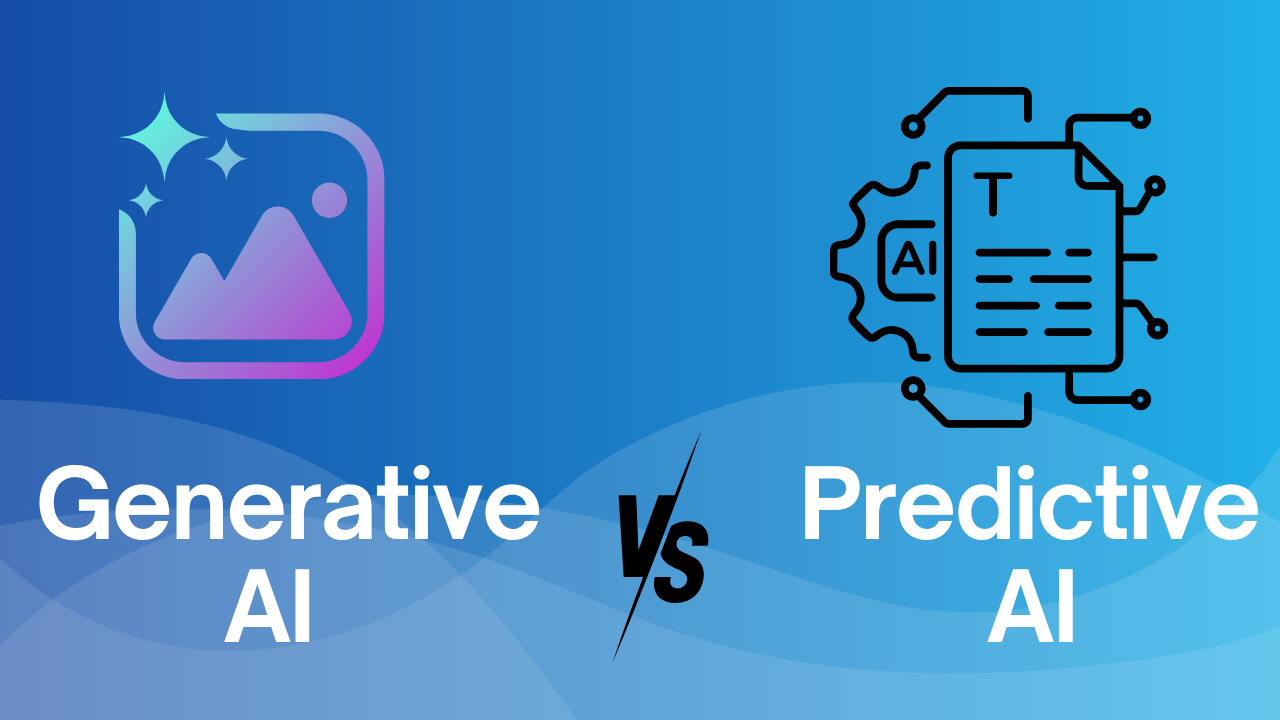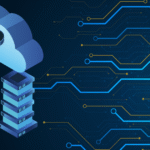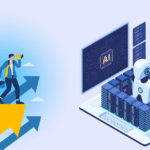Here, we have almost all heard about artificial intelligence becoming a buzzword. AI can reach to where nearly everything about us goes on in a single working day, from our automatic spam emails packed by bots to weather forecast apps. Sure, but did you know that there are various A.I. technologies and they work very differently?
Predictive AI and Generative AI are two of the most requisite categories. Though they may seem alike, they have distinct applications and mechanisms of action. An artist is different than a psychic — both are gifted but they have tendencies for different roles in their individual careers.
In this article, we’ll simplify everything you need to know about them. I will cover what sets them apart, show you a couple of real-world examples how they are used and give you an idea of what type is maybe suitable for your situation. By the end you will have a very clear idea of what some of these technologies are and how they influence the world today.
What Makes Generative AI Special?
If you’re thinking about this in terms of your own writing, think of generative AI as the creative assistant who always has fresh new ideas. This kind of AI is more like an expert that can produce new outputs. Generative AI is an area at the intersection of AI and Art, through which we can develop AI that writes stories, makes pictures, does music composition, even coding.
The miracle behind the generative AI is its learning patterns from huge content data. Think about reading millions of books, viewing countless paintings, and hearing all the songs ever. Finally, you’d at least have some insight into how to make a new game that is fresh and different but still familiar. Generative AI is pretty much that, but it’s just not humanly fast and big.
How Generative AI Actually Works
Here is how the process goes in practice: First, you do some training on a really large data set. A case in point could be an AI that writes text snippets, trained on multiple billions of web pages, books, articles or thousands of other types of written content. It recognizes patterns in the type of words, how they are arranged, and what they signify in the language during this training.
Generative AI does not simply copy an existing piece of content when you ask it to create something. It creates something new from the patterns it has learned. Like you’ve learned all the rules of cooking so well that you can dream up a new thing without looking in any imprecise and dusty cookbook for ideas.
The most impressive part? It quite literally thinks outside the box: Maybe two together ideas that seem like they might work, or even produce something new but it itself an idea that we would never have thought to generate. Here, many of our original AI creations are becoming Artists capable of creating an entire poem in the manner of Shakespeare on modern technology or a painting in combining different genres.
Popular Examples You’ve Probably Used
Generative AI is probably something you are already familiar with in fact:
- ChatGPT and other essay writing, question answering or even home-touching chatbot
- DALL-E, Midjourney and Stable Diffusion – This involves generating artwork and even images from text descriptions
- GitHub Copilot – Complete-Function Suggestion Writing Tool
- AI music generators – How to Write an Original Song in Any Style
- Video creation tools that can create realistic avatars or animations of people talking
Each month, these tools become more advanced, and are increasingly adorned with novel abilities that frequently shock even their builders.
AI vs Human: Predictive Power Explained
Generative AI is about creating something new, whereas predictive AI is all about what to expect next. This type of AI learns from historical data to predict future events, trends or features.
Predictive AI effectively functions as a crystal ball with the power of math and statistics. Instead of relying on magic or intuition, it employs complex algorithms to detect trends and relationships from data that humans might overlook by hand. The aim is not to invent something new but predict based on what has taken place in the past.
The Science Behind Prediction
Predictive AI looks for connections or patterns in large datasets. Like, it might look at weather data from past years and try to predict the weather for tomorrow, or it could analyze behavior of customers with a view what do different behavior patterns tell you about what someone wants to buy.
These processes usually entail the following steps:
- Data Collection: Gathering Historical Information
- Pattern Recognition: Recognising trends and relationships in the data
- Model Building: Creating the mathematical models that can predict what will happen next
- Testing and Validation: See how well our predictions align with true value
- Real-world Application: Applying the model to make actual forecasts
The more data a predictive AI has to work with, the better its accuracy. Larger the data, better are the predictions generally possible, but at the same time more data also need to be real and intuitive.
When You Meet Predictive AI Every Day
Predictive AI is working behind the scenes in quite a few places:
- Netflix and Spotify offers based on movies or songs you want to see
- Google Maps – it even predicts traffic for you and gives you alternate routes to prevent congestion
- Email spam filters that recognize which messages are to be blocked and so on
- Recommended online shopping product categories based on your past purchases
- Determinations of credit score, which estimate your probability of paying back loans
- The weather forecasts that tell you whether it will rain tomorrow and if you should bring an umbrella
These systems are constantly learning what they predict, refining their predictions based on new data and user feedback.
Key Differences That Matter
With that in mind, let’s get into the defining distinctions between these two types of AI. These differences shed a light on why they each perform better in certain situations and reasons, both are uniquely powerful in the modern tech ecology.
Purpose and Goals
| Aspect | Generative AI | Predictive AI |
| Main Purpose | Create new, novel content | Forecast future events or outcomes |
| Primary Goal | Innovation and creativity | Accuracy and insight |
| Output Type | Something that didn’t exist before | Predictions about existing patterns |
| Success Measure | Quality of produced content | Accuracy of predictions |
Data Requirements and Usage
This is another place data are handled differently by the AI types.
Generative AI Data Needs:
- Requires diverse, high-quality training examples
- Learning creative patterns requires massive datasets
- Focus on the content rich and engaging site
- Frequently consumes unstructured data like text, images, and audio
Predictive AI Data Needs:
- Depends on historical data with clear patterns
- Any platform or dataset requires data for the long-term period
- Data accuracy and relevancy is the priority
- Frequent use of structured data: numbers, dates, taxonomies
Learning Approaches
These types of AI are based on different approaches to how they should learn:
Generative AI Learning:
- Analyzes structure and style of current content
- The model learns to mix these elements in new ways
- Gains the power to produce theme variations
- Cover the spirit of creative designs
Predictive AI Learning:
- Analyzes relationships between different variables
- Discovers trends & relationships in historical data
- Builds mathematical models for forecasting
- Includes statistics are correct and can be relied upon
Real-World Applications That Shape Our Lives
Both AI types making much difference in the different sectors. The following is a slightly deeper dive into the practical usage and benefits of some AI in various sectors:
Generative AI in Action
Content Creation and Marketing Companies these days are using generative AI to create things like marketing materials, advertisements, entire advertising campaigns, social media posts. This technology enables personalised content at unprecedented scale, thereby helping businesses deliver messages direct to consumer interests and preferences.
Education and Learning Teachers and students are using AI-powered tools to make learning material, practice problems, educational contents of own. These tools help replicate this in digital form, writing exercises at the appropriate level for each student to enable high-quality personalized learning.
Software Development Programmers are repeatedly using AI coding assistants to author functions, debug problems and even develop complete applications. This speeds up the development cycle and allows developers to concentrate on high-level tasks.
Entertainment and Media The entertainment industry is experimenting with using AI to compose music, create paintings and even write movie and television scripts. Human control direction and creativity where AI help in widening the scope of content production that can be possible.
Predictive AI Making a Difference
Healthcare & Medicine Hospitals use predictive AI to predict patient needs, disease breakout, and which individuals are at risk for certain health conditions. It allows doctors to provide better care more efficiently.
Financial Services Banking and Finance: Prediction AI plays a crucial role in the financial services, with banks and investment firms using it to detect fraud, evaluate credit risk, and develop investment strategies. These systems are able to identify abnormal patterns that may suggest fraud or new openings in the market.
Transportation and Logistics Shipping companies in the domain of transportation and logistics also to a high level predict future with AI, such as optimizing deliveries routes using predictive AI, predicting vehicle maintenance needs by understanding patterns in engine failure data, or predicting demand for services like delivery. The result is a streamlining of operations and faster customer service.
Agriculture and Food Production Farmers are using predictive AI to predict crop yields, determine irrigation schedules and model pest outbreaks. These technologies help increase food production reducing waste and environmental impact.
Benefits and Challenges of Each Approach
There are always pros and cons of each technology. Generative vs Predictive: While both provide tremendous advantages, they come up with their own set of challenges that users and developers need to consider.
Advantages of Generative AI
Creative Possibilities
- Rapid content creation at scale
- Overcome creative blocks and generate new ideas
- Enables content customization for different type people
- Saves Time and Money on Content Production
Accessibility Benefits
- Enables non-skilled users to have creative tools at their disposal
- Lends itself to a wide range of content creators
- Given Support for Disabled Person
- Translation and interpreter services to include any language
Innovation Driver
- Accelerates research and development processes
- Ideal for trying new ideas and concepts
- Supports rapid prototyping and iteration
- Enables New Business Models
Challenges Facing Generative AI
Quality and Accuracy Concerns
- This content generated is subject to errors and inaccuracies
- Difficulty in ensuring factual correctness
- Potential For One-Sided Or Unfit Content
- Human intervention and confirmation
Ethical and Legal Issues
- Copyright and Intellectual Property Questions
- Creating disinformation or fake content
- Some privacy related to training data
- Responsible AI development practices
Advantages of Predictive AI
Decision Support
- Provides Decision Making Tools Based on Data
- Assists organizations to be able to plan for future scenarios
- Reduces uncertainty in business planning
- This allows brands to be proactive instead of reactive in their approach
Efficiency Improvements
- Optimizes resource allocation and utilization
- It minimizes losses and enhances productivity
- Automates routine forecasting tasks
- Allows to anticipate customer need well prior
Risk Management
- Detect discrepancies in advance
- Prevents Fraud & Security Breaches
- Facilitates timely alert systems for multiple categories
- Help businesses prepared against future challenges
Challenges in Predictive AI
Data Dependency
- Requires high-quality, relevant historical data
- Performance based on how accurate and complete your data is
- May struggle with unprecedented situations
- Accuracy – Continues data updates are required to improve accuracy
Prediction Limitations
- Limited to occurrence of purely random or unexpected events
- Possible to perpetuate the existing bias in historical data
- Accuracy decreases for longer-term predictions
- Needs human experts to interpret and contextualize data
Choosing the Right AI for Your Needs
Whether generative or predictive AI is better depends on the intent. Each type has its own strengths, and there might be situations when you can get advantage in combining them.
When Generative AI is the Best Option
Content Creation Projects Generative AI is typically the best choice if you intend to create original content. This includes:
- Articles (event, drama and fiction) Copywriting
- Artwork, logos or designs
- Generating music or audio content
- Developing prototypes or creative concepts
Brainstorming and Ideation If you need new ideas, or want to discover creative options that pair well together, generative AI can inspire new avenues of discovery and a starting point that may not have crossed your mind.
Personalization with Scale If you have to create hundreds of unique pieces for a variety of users or scenarios, generative AI can generate variations rapidly while ensuring the quality and relevance.
When Predictive AI Is Preferable
Planning & Forecasting For every decision based on a future trend or event, there is predictive AI:
- Business planning and resource allocation
- Investment decisions and financial planning
- Inventory optimization and supply chain management
- Risk assessment and mitigation strategies
Pattern Recognition Tasks Whether you are identifying trends or anomalies in data, which is the case for the pattern recognition tasks. If what you are grappling with involves spotting patterns that a human may not be able to notice easily.
Optimization Problems When trying to make existing processes more efficient or the hardware better fit for a specific use-case and improve its performance, Predictive AI can be used to explore what are good ways of doing so based on historical data.
Combining Both Approaches
In fact, it’s often the combination of both types working together that can deliver truly transformational results:
Content Strategy Thanks to predictive AI, we can figure out what kind of content will work best for us; this is because generative AI and creation of that specific content will be done fast.
Individualized User Experiences Start interesting applications of using predictive AI to anticipate what a user might want, then mix that with generative AI to deliver matching personalized content.
Product Development Use predictive AI to find market opportunities + trends — then use generative AI to prototype & test new product concepts fast.
The Future Of AI: What To Expect Next
Generative AI and predictive AI – There are many advances in both generative and predictive AI that come out every week, the field is evolving so quickly. And it is only going to get more advanced than today with wider application solutions throughout different industry.
Emerging Trends in Generative AI
The Age of Multimodality Future generative AI systems will be able to generate both books and music or songs, seamlessly flipflopping between types of content to create efficient experiences that blend text, image, sound, and video.
Improved Quality and Control Developers are focused on making generative AI more controllable, to allow you to specify exactly what you want, and they make sure models reliably produce output matches your specifications.
Real-time Collaboration Imagine tools that make real-time collaboration human and AI, with AI as a creative partner instead of merely a content engine.
Advances in Predictive AI
Better Accuracy and Reliability Improved Predictive AI systems are more accurate and less brittle, outputting not only predictions but also confidence levels and alternative scenarios as well.
Faster Processing Better Handling of Inputs Improvements in computing power and algorithms are helping the predictive capabilities within AI to become more distributed, faster to process, making it easier for time sensitive applications to provide real-time predictions.
Explainable Predictions Since the end of last year, Explainable Predictions was being taken up by cutting-edge systems making predictive AI algorithm more transparent as to why it is predicting what it predicts and how confident it could be in its forecasts.
Integration and Convergence
Hybrid Systems Generative and predictive capabilities are being paired in AI systems that are capable of generating answers as well as making some (or all) categories of predictions.
Industry-Specific Solutions Specialized features & capabilities Both — AI are focused, industry specific solutions that cater to unique use cases and requirements.
Ethical AI Development This trend is indicative of a broader awareness around responsible AI development — from the incorporation of fairness in predictive systems to improved transparency features that allow you to understand how an AI system arrived at its conclusion.
Making Sense of the AI Revolution
The generative/predictive distinction is more than just technical: it represents two different philosophical and practical pathways to harnessing AI for the betterment of human well-being. Generative AI has rekindled our ability to create, and it has made us produce ideas and content in numbers never before imaginable. Predictive AI is used to make better decisions and give us a new look from which we can use this complex world.
And both types of AI is changing the landscape across industries, opening up new possibilities and disrupting ways we do business. This means creativity is being democratized through the dawn of generative AI and giving access to new age content creation tools to everyone. On the flip side of things, predictive AI is transforming businesses into intelligent companies by enabling them to do more with data.
The point is the solution to thrive in this AI driven world is not between generative and predictive AI but knowing which fits where. Use case appropriate AI methods may be combined to provide the most innovation solutions.
With advancements providing these lines between creating and predicting to blur, time will tell (quite literally) about what the future tech landscape holds. This suggests a future where AI systems will not only generate creative solutions, but also predict the success of those solutions — and in turn create a feedback loop that rapidly accelerates innovation and performance.
Generative vs. predictive AI: A guide for the curious — no matter if you are a business owner, student or creative professional, one of the first steps on how to decide which tool is right for a job and when to apply it stems from developing an understanding of such difference. This increasingly will be the knowledge that helps us navigate the opportunities and challenges in an AI-enabled world.
The AI revolution is in its early stages, and the future will not be exclusively generative or predictive: inclusive growth requires a mix. The more you understand these, the better placed you are to capitalise upon what wonderful opportunities this gives us.
FAQ
1. What makes Generative AI special?
Generative AI is like a creative assistant that can produce new outputs such as stories, pictures, music, and even code by learning patterns from large amounts of data.
2. How does Generative AI actually work?
It is trained on massive datasets, recognizes patterns in the structure and style of content, and creates something new based on those patterns rather than copying existing material.
3. What is Predictive AI all about?
Predictive AI learns from historical data to forecast future events, trends, or outcomes, functioning like a crystal ball powered by math and statistics.
4. Where might you meet Predictive AI every day?
Examples include Netflix and Spotify recommendations, Google Maps traffic predictions, spam email filters, online shopping suggestions, credit score calculations, and weather forecasts.
5. When is Generative AI the best option?
It is best for creating original content like articles, artwork, music, prototypes, brainstorming ideas, and personalizing large volumes of content.











